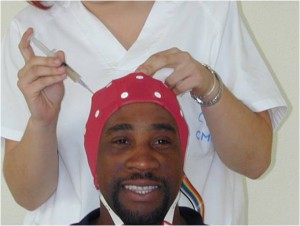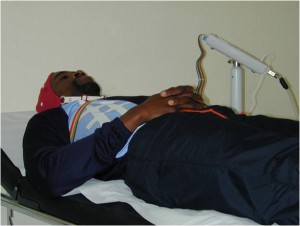There is no doubt: the brain is the dominant performance organ of the athlete.
Of course the brain consists of many different levels and parts.
In sports a lot of tests have been developed for everything below the head: muscle biopsies, EKG, blood panels, etc. But all of these tell us very little about the functioning of the brain itself.
Yes, there are HRV tests which claim to measure brain function, but HRV only tells us something about the autonomic nervous system (and basically only about the part that innervates the cardiac system). No matter the importance of the autonomic nervous system for athletes – think about recovery – it is certainly not the whole picture nor does it tell us anything about the brain as a whole or about cognitive qualities.
What is needed to measure to functioning of the brain as a whole?
First I used EEG or classical brainwave analysis of beta, alpha, theta, delta and SMR waves.
But this gives you very little information about e.g. fatigue, overtraining, or performance levels. Getting relevant and significant information from EEG about sports performance-related factors is very, very difficult and certainly not something you want to do on a daily basis

The only measurement that has proven its value is also one of the oldest and certainly one of the most simple measurements existing i.e. measuring DC brain potential.
Many of you might think this a recent and/or esoteric measurement, but as a matter of fact DC-potential measurements go back to the 1930’s and have been widely used ever since.
It is not easy to find DC-potential research. This is caused by two facts:
1. a lot of it was done in the former Soviet-Union and not translated;
2. DC-potential was given many different names by different researchers: e.g. slow cortical potential, steady potential, quasi-steady potential, infraslow cortical potential, ultraslow cortical potential, omega potential, etc.
For readers interested in its history, have a look at the bibliography at the end this article.
To make it simple: DC-potential is a very slow brainwave, <0.5 Hz, and can be measured with two simple electrodes, one on the thenar of the right hand and the other on the forehead.
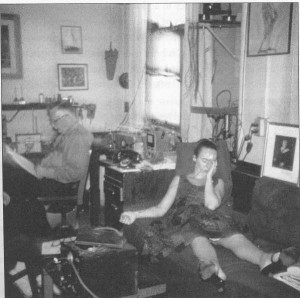
The principle is simple: the brain produces electricity, and stores electricity just like a battery.
The brain can produce too much electricity (e.g. epilepsy) but mostly when things go wrong it runs out of electricity by using it too intensively and/or too long. The normal value for the brain is between 0 and 46 millivolt.
This voltage also expresses the wakefulness, also called the level of activation or the arousal level of the central nervous system.
An optimal voltage is necessary for useful adaptation as a response to the training load.
.
A voltage lower than 0 is called central nervous fatigue (yes, this is it). This is a (temporary) inability of the brain to produce enough electricity to function optimally. The voltage of the brain can be changed by information overload, by exercise, by nutrition and supplementation and by medication.
Below you see an example of an Omegawave test taken before and after a long, exhaustive technical and specific training with a world class female tennis player. Note the drop in voltage from 13.0 to a minus 28 millivolt. Yes, this kind of training is demanding a lot from the brain.
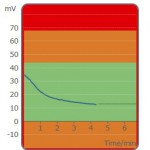
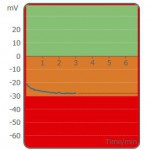
Before the workout: 13.0 millivolt After the workout: -28.0 millivolt
Central nervous fatigue causes many of the unexplained errors, mistakes, or accidents. Athletes will tell you: “I forgot”, “I didn’t see that”, “I didn’t hear that”, “I don’t know what happened”, “it just happened”, etc. Take a look at their DC-potential.
Their brain just wasn’t sharp enough to do the right thing at the right place and the right time. We coaches then think, well it is a matter of attention. So we tell the athlete to be more focused next time. Won’t work: it is switching on a torchlight with empty batteries!
Think about factors such as attention, coordination, precision, communication, quality of movement, efficiency, fatigue (CNS), motor learning, etc. All of these can only function optimally when the brain is fully charged.
Measuring the level of DC-potential helps us detecting central nervous fatigue, understanding its impact on performance and discovering the effects of different training sessions and different interventions. This helps us to implement optimization of training beyond just the words.
Bibliography:
Aladjalova, N.A: Slow electrical processes in the brain; Elsevier, 1964.
Burr, H.S: Blueprint for immortality; C.W.Daniel, 1972.
Sologub, J, B; Elektroenzephalographie im Sport J.A.Barth Verlag, Leipzig, GDR, 1976.
Bechtereva, N.P: The neurophysiological aspects of human mental activity; Oxford University Press, 1978.
Ilyukhina, V.A; Kiryanova, R.E; Baez, E: Infraslow processes of the human brain and organization of mental activity; in: Psychophysiology.Today and Tomorrow; Pergamon Pess, 1981.
Becker, R.O: Crosscurrents; Tarcher/Putnam, 1990.
McCallum, W.C; Curry, S.H: Slow potential changes in the human brain; Plenum Press, 1993.

